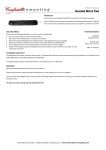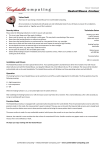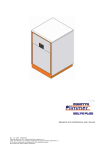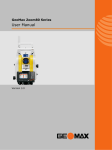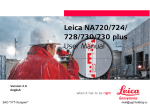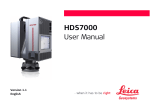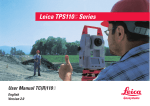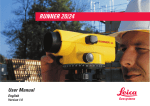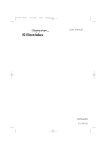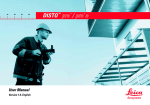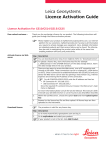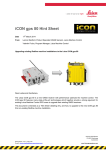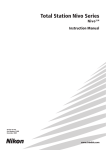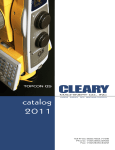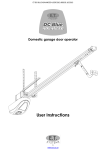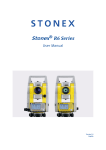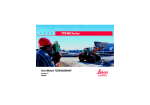Download SNLL121
Transcript
SNLL121 User Manual Lalot01 Version 2.1 English © Leica Geosystems SNLL121-2.1.0en 1 Congratulations on your purchase of this Leica instrument. This manual contains important safety directions (refer to chapter "Safety directions") as well as instructions for setting up the product and operating it. Read carefully through the User Manual before you switch on the product. Product identification The model designation and the serial number of your product can be found on the data plate outside of the housing. Enter model and serial number in your User Manual, and always refer to this information when you need to contact your agency or authorized service workshop. Type: 2 Serial no.: SNLL121-2.1.0en © Leica Geosystems Symbols used in this manual The symbols used in this User Manual have the following meanings: DANGER: Indicates an imminently hazardous situation which, if not avoided, will result in death or serious injury. WARNING: Indicates a potentially hazardous situation or an unintended use which, if not avoided, could result in death or serious injury. CAUTION: Indicates a potentially hazardous situation or an unintended use which, if not avoided, may result in minor or moderate injury and/or appreciable material, financial and environmental damage. Important paragraphs which must be adhered to in practice as they enable the product to be used in a technically correct and efficient manner. © Leica Geosystems SNLL121-2.1.0en 3 Contents Symbols used in this manual ..................................... 3 Contents ....................................................................... 4 Description of Instrument .......................................... 5 Sensor Nadir Laser plummet type SNLL121 ........................... 5 Functions ..................................................................... 6 ON/OFF ..................................................................................... 6 Function AutoOff ....................................................................... 6 Laser brightness ......................................................................... 7 Weak battery .............................................................................. 7 Replacing batteries .................................................................... 8 Setting up ..................................................................... 9 Setting up over ground point ..................................................... 9 Checking and Adjusting .......................................... 11 Care and Storage ...................................................... 13 Safety Directions ....................................................... 15 Intended use of instrument ...................................................... 15 Limits to use ............................................................................ 16 Responsibilities ........................................................................ 17 Hazards of use .......................................................................... 18 Laser classification .................................................................. 21 Electromagnetic Compatibility (EMC) ................................... 24 FCC statement (applicable in U.S.) ........................................ 25 Technical Data........................................................... 27 4 SNLL121-2.1.0en © Leica Geosystems Description of Instrument Lalot03 Sensor Nadir Laser plummet type SNLL121 • For centering the tripod over ground points. • For general-purpose plumbing. • For mounting reflector holders and sensors. © Leica Geosystems SNLL121-2.1.0en 5 Functions ON/OFF Function AutoOff The laser plummet is switched off automatically after four minutes. Lalot05 This function is always active. Press briefly for switching on the laser plummet. 6 SNLL121-2.1.0en © Leica Geosystems Weak battery Lalot17 Lalot06 Laser brightness Permanent pressing changes brightness of laser. Lalot07 If laser beam and diode are flashing the capacity of the battery is too low. Laser weak Laser intensive Always have spare batteries with you. This will ensure that work can be completed without discontinuation. The brightness adjustment remains active even after switching off the laser plummet. © Leica Geosystems SNLL121-2.1.0en 7 Replacing batteries Lalot08c 3. Insert new batteries. Lalot08a 1. Remove cover. Insert batteries correctly. 4. Insert battery holder and close cover correctly. Lalot08d Lalot08b 2. Pull out battery holder and remove batteries. Always replace the complete battery set. • Do not use old and new batteries together. • Do not use batteries from different manufacturers or batteries of different types. • For type of battery, refer to Technical Data. 8 Pay attention to the correct position of the battery holder: contacts on underside and pointing into instrument. SNLL121-2.1.0en © Leica Geosystems Setting up Setting up over ground point 2 3 1 Lalot09a 1 Lalot09b 1 1. Set up tripod with tribrach as vertically as possible above the ground point. 2. Insert laser plummet into the tribrach and switch on. 3. Turn the base screws of the tribrach until the laser spot coincides with the ground point. No objects between laser plummet and target point. © Leica Geosystems SNLL121-2.1.0en 9 4. By adjusting the length of the tripod legs level-up the circular level. 4 5. By turning the footscrews level-up the spirit level (midpoint). Now the tribrach is leveled up exactly. 4 Lalot10 4 4 6. Shift the tribrach on the tripod until the laser spot coincides again with the ground point. Check levelling and repeat steps 5 and 6 of this procedure until the required positioning accuracy is reached. For a precise set-up it is absolutely necessary to levelup by using the spirit level. Always lock laser plummet in the tribrach! 10 SNLL121-2.1.0en © Leica Geosystems Checking and Adjusting Under normal circumstances adjusting the laser plummet is not necessary. Checking by turning the instrument by 360°: 1. Install the instrument on the tripod and level up. 2. Switch on laser plummet and mark centre of the red point. 3. Turn instrument slowly by 360° and observe the red laser spot. Checking the laser plummet must be carried out on a bright, even and horizontal surface (e.g. sheet of paper). Lalot11 360° Laser spot: diam. 2.5 mm / 1.5 m ≤ 1.0 mm / 1.5 m If the centre of the laser spot makes a clearly circular movement or if the centre of the spot moves away more than 1mm from the first marked point an adjustment may be necessary. Call your nearest Leica Geosystems service workshop. © Leica Geosystems SNLL121-2.1.0en 11 Depending on brightness and surface the size of the laser spot can vary. At a distance of 1.5 m its average diameter is 2.5 mm. The maximum diameter of the circular movement described by the centre of the laser spot should not exceed 1 mm at a distance of 1.5 m. Adjusting the spirit level 1. 2. Δ Lalot12b Lalot12a 180° If Δ > 1 interval the spirit level must be adjusted 3. Lalot12c Δ/2 Correct half of deviation (Δ/2) using an Allen key and repeat steps 1 to 3 of this procedure until bubble is centered. 12 SNLL121-2.1.0en © Leica Geosystems Care and Storage Transport: When dispatching the equipment, always use the complete original optional Leica Geosystems packaging. When transporting the equipment in the field, always make sure to: • either carry the instrument in its original optional transport case or • carry the tripod with its legs splayed across your shoulders, keeping the attached laser plummet upright. Lalot14 Lalot13 Remove batteries from the laser plummet when it is shipped via rail, air or sea transport. © Leica Geosystems SNLL121-2.1.0en 13 Storage: When storing the equipment, particularly in summer and inside a vehicle, take the storage temperature limits (-40°C to + 70°C / -40°F to +158°F) into account. Damp instruments must be unpacked. Dry the instrument, the case, the foam inserts and the accessories at not more than 40°C / 108°F and clean them. Do not repack until everything is completely dry. For long period of storage, remove batteries from the instrument. After a longer period of storage or transport of your instrument, always perform the field adjustments indicated in this manual before using the instrument. 14 SNLL121-2.1.0en © Leica Geosystems Safety Directions The following directions should enable the person responsible for the laser plummet, and the person who actually uses the instrument, to anticipate and avoid operational hazards. The person responsible for the instrument must ensure that all users understand these directions and adhere to them. Intended use of instrument Permitted uses The permitted uses of the laser plummet are the following: • Centering the tripod above ground points • General purpose plumbings • Adjustment of reflectors and sensors Adverse uses • Use of the product without instruction. • Use outside of the intended limits. • Disabling safety systems. • Removal of hazard notices. • Opening the product using tools (screwdriver, etc.), unless this is specifically permitted for certain functions. • Modification or conversion of the product. • Use after misappropriation. • Use of products with obviously recognizable damages or defects. • Use with accessories from other manufacturers without the prior express approval of Leica Geosystems. • Inadequate safeguards at the surveying site (e.g. when measuring on roads, etc.). • Deliberate dazzling of third parties © Leica Geosystems SNLL121-2.1.0en 15 WARNING: Adverse use can lead to injury, malfunction, and material damage. It is the task of the person responsible for the instrument to inform the user about hazards and how to counteract them. The product is not to be used until the user has been properly instructed how to use it. Limits to use Environment: Suitable for use in an atmosphere appropriate for permanent human habitation: not suitable for use in aggressive or explosive environments. Use in rain is permissible for limited periods. See chapter "Technical Data". DANGER: Local safety authorities and safety experts must be contacted before working in hazardous explosive areas or in extreme environment conditions by the person in charge of the instrument. This includes the use of a lockable battery holder to prevent accidental opening of the compartment. 16 SNLL121-2.1.0en © Leica Geosystems Responsibilities Area of responsibility for the manufacturer of the original equipment Leica Geosystems AG, CH-9435 Heerbrugg (hereinafter referred to as Leica Geosystems): Leica Geosystems is responsible for supplying the product, including the User Manual and original accessories, in a completely safe condition. Responsibilities of the manufacturers of non-Leica Geosystems accessories: The manufacturers of non-Leica Geosystems accessories for the laser plummet are responsible for developing, implementing and communicating safety concepts for their products, and are also responsible for the effectiveness of those safety concepts in combination with the Leica Geosystems product. Responsibilities of the person in charge of the instrument: WARNING: The person responsible for the instrument must ensure that it is used in accordance with the instructions. This person is also accountable for the training and deployment of personnel who use the instrument and for the safety of the equipment when in use. The person in charge of the instrument has the following duties: • To understand the safety instructions on the product and the instructions in the User Manual. • To be familiar with local regulations relating to accident prevention. • To inform Leica Geosystems immediately if the equipment becomes unsafe. © Leica Geosystems SNLL121-2.1.0en 17 Hazards of use Main hazards of use WARNING: The absence of instruction, or the inadequate imparting of instruction, can lead to incorrect or adverse use, and can give rise to accidents with far-reaching human, material, financial and environmental consequences. Precautions: All users must follow the safety directions given by the manufacturer and the directions of the person responsible for the instrument. CAUTION: Watch out for erroneous measurements if the instrument is defective or if it has been dropped or has been misused or modified. Precautions: Periodically carry out test measurements and perform the field adjustments indicated in the User Manual particularly after the instrument has been subjected to abnormal use and before and after important measurements. WARNING: By surveying during a thunderstorm you are at risk from lightening. Precautions: Do not carry out field surveys during thunderstorms. 18 SNLL121-2.1.0en © Leica Geosystems WARNING: Inadequate securing of the surveying site can lead to dangerous situations, for example in traffic, on building sites and at industrial installations. Precautions: Always ensure that the surveying site is adequately secured. Adhere to the local regulations governing accident prevention and road traffic. CAUTION: During the transport or disposal of charged batteries it is possible for inappropriate mechanical influences to constitute a fire hazard. Precautions: Remove the batteries from their compartement before they are transported. Dispose of batteries only if they are fully flat. CAUTION: If the accessories used with the instrument are not properly secured, and the equipment is subjected to mechanical shock (e.g. blows, falling etc.), the equipment may be damaged, safety devices may be ineffective or people may sustain injury. Precautions: When setting-up the instrument, make sure that the accessories (e.g. tripod, tribrach, etc.) are correctly adapted, fitted, secured and locked in position. Avoid subjecting the equipment to mechanical shock. Never position the instrument on the tripod baseplate without securely tightening the central fixing screw. If the screw is loosened always remove the instrument immediately from the tripod. © Leica Geosystems SNLL121-2.1.0en 19 If the product is improperly disposed of, the following can happen: If polymer parts are burnt, poisonous gases are produced which may impair health. If batteries are damaged or are heated strongly, they can explode and cause poisoning, burning, corrosion or environmental contamination. By disposing of the product irresponsibly you may enable unauthorized persons to use it in contravention of the regulations, exposing them-selves and third parties to the risk of severe injury and rendering the en-vironment liable to contamination. Improper disposal of silicone oil may cause environmental contamination. Precautions: The product must not be disposed with household waste. Dispose of the product appropriately in accordance with the national regula-tions in force in your country. Always prevent access to the product by unauthorized personnel. Product specific treatment and waste management information can be downloaded from the Leica Geosystems home page at http:// www.leica-geosystems.com/treat-ment or received from your Leica Geosystems dealer. 20 SNLL121-2.1.0en © Leica Geosystems Laser classification The laser plummet produces a visible laser beam emerging from the underside of the instrument. The product is a Class 2 laser product in accordance with: • IEC 60825-1:1993 "Safety of laser products". • EN 60825-1:1994 + A11:1996 "Safety of laser products". The product is a Class II laser product in accordance with: • FDA 21CFR Ch.I §1040: 1988 (US Department of Health and Human Service, Code of Federal Regulations) Class 2/II laser products: Do not stare into the beam or direct it unnecessarily at other persons. Eye protection is normally afforded by aversion responses including the blink reflex. Description Value Beam divergence 0.16 mrad x 0.6 mrad Pulse duration c.w. Maximum radiant power 0.95 mW Measurement uncertainty ± 5% WARNING: It can be dangerous to look into the beam with optical equipment (e.g. binoculars, telescopes) Precautions: Do not look directly into the beam with optical equipment. © Leica Geosystems SNLL121-2.1.0en 21 Labelling Lalot16 Laser Radiation Do not stare into beam Class 2 Laser Product accord. to IEC 60825-1:1993 P0 ≤ 0.95 mW λ = 620 - 690 nm This device complies with part 15 of the FCC Rules. Operation is subject to the following two conditions: (1) This device may not cause harmful interference, and (2) this device must accept any interference received, including interference that may cause undesired operation. This laser Product complies with 21CFR 1040 as applicable 22 SNLL121-2.1.0en © Leica Geosystems Lalot19 Type: SNLL121 Lalot15a Lalot20 Art.No.: ...... Power: 6V=nominal, 200mA max. Leica Geosystems AG CH-9435 Heerbrugg Manufactured:2004 S.No.: ...... Made in Switzerland Laser beam (visible) Laser beam outlet (visible) CAUTION: Only Leica Geosystems authorized workshops are entitled to repair these products. © Leica Geosystems SNLL121-2.1.0en 23 Electromagnetic Compatibility (EMC) The term "electromagnetic acceptability" is taken to mean the capability of the instrument to function correctly in an environment where electromagnetic radiation and electrostatic discharges are present, and without causing electromagnetic disturbances in other equipment. WARNING: Electromagnetic radiation can cause disturbances in other equipment. Although the laser plummet meets the strict regulations and standards which are in force in this respect, Leica Geosystems cannot completely exclude the possibility that other equipment may be disturbed. CAUTION: Disturbances caused by electromagnetic radiation can result in the tolerance limits for measurements being exceeded. Although the laser plummet meets the strict regulations and standards which are in force in this connection, Leica Geosystems cannot completely exclude the possibility that the laser plummet may be disturbed by very intense electromagnetic radiation, e.g. near radio transmitters, walkie-talkies, diesel generators, power cables. Check the plausibility of results obtained under these conditions. 24 SNLL121-2.1.0en © Leica Geosystems FCC statement (applicable in U.S.) WARNING: This equipment has been tested and found to comply with the limits for a Class B digital device, pursuant to part 15 of the FCC Rules. These limits are designed to provide reasonable protection against harmful interference in a residential installation. This equipment generates, uses and can radiate frequency energy and, if not installed and used in accordance with the instructions, may cause harmful interference to radio communications. However, there is no guarantee that interference will not occur in a particular installation. If this equipment does cause harmful interference to radio or television reception, which can be determined by turning the equipment off and on, the user is encouraged to try to correct the interference by one or more of the following measures: • Reorient or relocate the receiving antenna. • Increase the separation between the equipment and receiver. • Connect the equipment into an outlet on a circuit different from that to which the receiver is connected. • Consult the dealer or an experienced radio/TV technician for help. © Leica Geosystems SNLL121-2.1.0en 25 WARNING: Changes or modifications not expressly approved by Leica Geosystems for compliance could void the user's authority to operate the equipment. Product labelling: This device complies with part 15 of the FCC Rules. Operation is subject to the following two conditions: (1) This device may not cause harmful interference, and (2) this device must accept any interference received, including interference that may cause undesired operation. 26 SNLL121-2.1.0en Lalot21 This device complies with part 15 of the FCC Rules. Operation is subject to the following two conditions: (1) This device may not cause harmful interference, and (2) this device must accept any interference received, including interference that may cause undesired operation. © Leica Geosystems Technical Data Location of laser in the centre; turns with instrument Accuracy max. diameter of the circular movement of the laser point: ≤ 1.0 mm / 1.5 m Diameter of laser spot 2.5 mm / 1.5 m Level sensitivity 30" / 2 mm Automatic switch-off ~ 4 min. after key is last pressed Light source, red laser diode 620 - 690 nm Laser class 2 Power supply 4 x 1.5V alkaline-Mn cells Type AA (LR6, AM3, Mignon) Protection / Sealing IP54, in accordance with IEC 60529 (splash-proof) Dimensions Height Diameter Weight 1080 g (2.4 lbs) Temperature range Operation Storage -20 °C (-4°F) to +50 °C (122°F) -40 °C (-40°F) to +70 °C (158°F) © Leica Geosystems IEC60825-1; EN60825-1 II FDA 21 CFR Ch.I § 1040 SNLL121-2.1.0en 153 mm 102 mm 27 Leica Geosystems AG, Heerbrugg, Switzerland, has been certified as being equipped with a quality system which meets the International Standards of Quality Management and Quality Systems (ISO standard 9001) and Environmental Management Systems (ISO standard 14001). Total Quality Management Our commitment to total customer satisfaction Ask your local Leica Geosystems agent for more information about our TQM program. 664969-2.1.0en Printed in Switzerland - Copyright Leica Geosystems AG, Heerbrugg, Switzerland 2006 Original text Leica Geosystems AG CH-9435 Heerbrugg (Switzerland) Phone +41 71 727 31 31 Fax +41 71 727 46 73 www.leica-geosystems.com




























